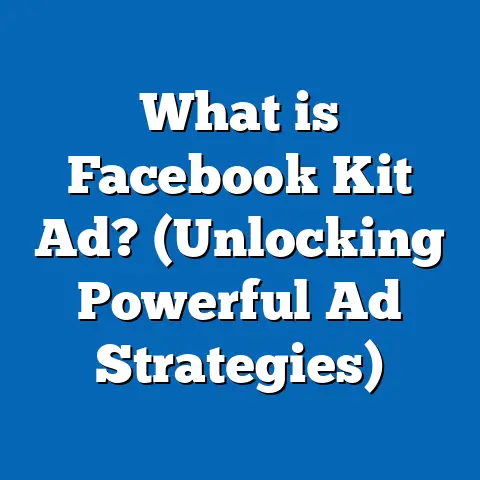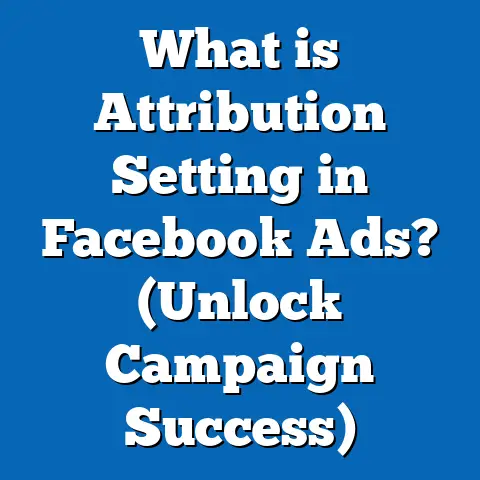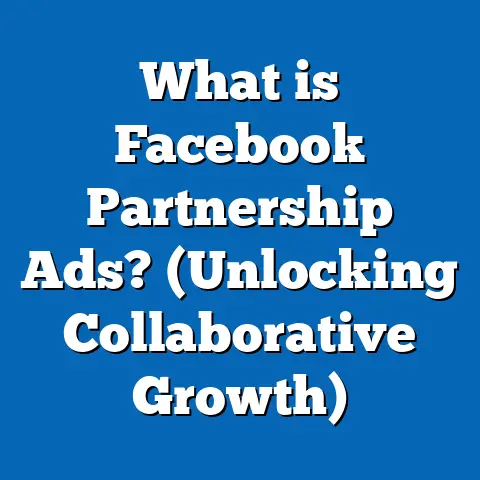What is Custom Conversion in Facebook Ads? (Unlock Targeting Power)
What is Custom Conversion in Facebook Ads? (Unlock Targeting Power)
Introduction: Why Should You Care About Custom Conversions?
Ever wondered how some advertisers seem to know exactly who to target with their Facebook ads, almost as if they have a secret map to the buyers’ journey? What if you could pinpoint the exact actions users take after clicking your ads—not just clicks and views—and use that information to target people with laser precision? That’s exactly what Custom Conversions can do for your Facebook advertising.
Facebook Ads have transformed digital marketing by offering unmatched reach and targeting capabilities. However, without precise conversion tracking, much of your ad budget can be wasted on users who don’t take meaningful actions. Custom Conversions allow you to move beyond simple metrics like click-through rates (CTR) and impressions to track the specific behaviors that drive real business results—be it purchases, signups, downloads, or other valuable actions.
This guide will take you through everything you need to know about Custom Conversions: what they are, how they work, setup instructions, data-backed benefits, advanced strategies, comparisons with other Facebook tools, and real-world use cases. By the end, you’ll understand how to unlock the full targeting power of Facebook Ads and maximize your return on ad spend (ROAS).
Table of Contents
- Understanding Custom Conversions: The Basics
- The Importance of Custom Conversions in Modern Marketing
- How Custom Conversions Work: Technical Overview
- Setting Up Custom Conversions: Step-by-Step Guide
- Common Mistakes and How to Avoid Them
- Advanced Custom Conversion Strategies
- Case Studies: Real Businesses Using Custom Conversions Successfully
- Comparing Custom Conversions with Other Facebook Pixel Tools
- Navigating Privacy Changes and Their Impact on Conversion Tracking
- Measuring Success: Metrics and KPIs to Track
- Practical Tips for Optimizing Your Campaigns with Custom Conversions
- Future of Conversion Tracking on Facebook
- Summary and Next Steps
Understanding Custom Conversions: The Basics
What Are Custom Conversions?
Custom Conversions allow you to define specific events or actions on your website that matter most to your business goals. Unlike standard Facebook Pixel events—which track common actions like “Add to Cart” or “Purchase”—Custom Conversions let you tailor conversion tracking based on URL rules or parameters without needing extra code.
For example, if your website has a unique thank-you page URL after someone completes a newsletter signup or a purchase, you can create a Custom Conversion that tracks visits to that URL as a successful conversion.
Why Are Custom Conversions Essential?
- Precision Tracking: Measure specific outcomes rather than generic behaviors.
- Better Optimization: Tell Facebook’s algorithm exactly what action you want to optimize for.
- Enhanced Targeting: Build audiences based on precise conversion actions.
- Improved Reporting: Gain clear insights into how many users complete valuable steps.
The Importance of Custom Conversions in Modern Marketing
The Shift from Clicks to Conversions
In the early days of digital advertising, clicks were the primary metric for success. But clicks alone don’t guarantee revenue or business growth. According to a 2023 study by Digital Marketing Insights:
- Only 2% of clicks convert into sales on average.
- Advertisers optimizing for conversions rather than clicks saw a 30% increase in ROAS.
- Businesses using granular conversion tracking reduce their cost per acquisition (CPA) by up to 25%.
This shift means marketers must go beyond surface-level metrics and focus on what truly drives business value.
Why Facebook Ads Need Custom Conversion Tracking
Facebook’s algorithm thrives on data. The more precise data you feed it about your customers’ behaviors, the better it can optimize ad delivery. Without custom conversions:
- You may optimize for less valuable actions (e.g., clicks instead of purchases).
- You lose the ability to build segmented retargeting audiences based on specific actions.
- Your reporting becomes vague and less actionable.
In essence, custom conversions unlock the targeting power that makes Facebook advertising highly effective.
How Custom Conversions Work: Technical Overview
The Role of Facebook Pixel
The Facebook Pixel is a JavaScript code added to your website that collects data about visitors’ actions. It tracks page views by default but can also track predefined standard events like:
- Add to Cart
- Initiate Checkout
- Purchase
- Lead
Custom Conversions add another layer by allowing you to define conversion events based on URL rules or parameters without needing to modify pixel code directly.
URL-Based Rules Explained
When setting up a custom conversion, you specify rules that determine when a conversion should be recorded. This usually involves URLs:
- Equals: Track conversions when visitors hit an exact URL (e.g., https://example.com/thank-you).
- Contains: Track all URLs containing certain keywords or paths (e.g., any URL containing “/purchase-confirmation”).
- Starts With: Track URLs starting with a certain path.
Facebook then records a conversion whenever a visitor meets these criteria.
Event Parameters and Dynamic Values
Besides URLs, Custom Conversions can also be set up using URL parameters (e.g., ?orderValue=100). This allows you to assign dynamic values like purchase amounts or lead scores for more detailed optimization.
Setting Up Custom Conversions: Step-by-Step Guide
Creating Custom Conversions is straightforward but requires careful attention to detail.
Step 1: Install the Facebook Pixel Properly
If you haven’t already:
- Go to Events Manager in your Facebook Business Manager.
- Create or select an existing Pixel.
- Add the pixel code to every page of your website using manual code insertion or via tag managers like Google Tag Manager.
Step 2: Navigate to Custom Conversions Section
- In Events Manager, click on “Custom Conversions” in the left-hand menu.
- Click “Create Custom Conversion.”
Step 3: Define Conversion Rules Based on URLs
- Select the Pixel associated with your site.
- Set your conversion rule based on URL criteria (e.g., “URL contains /thank-you”).
- Choose the conversion category that best fits your goal (Purchase, Lead, Complete Registration, etc.).
Step 4: Name Your Conversion and Assign Value
Name your conversion clearly (e.g., “Newsletter Signup May 2025”).
Optionally assign a monetary value if relevant for ROI tracking.
Step 5: Save and Test Your Custom Conversion
Once saved:
- Use the “Test Events” tool in Events Manager.
- Simulate actions on your website that should trigger the custom conversion.
- Confirm events are firing correctly.
Common Mistakes and How to Avoid Them
Mistake 1: Using Broad URL Rules
Using very general rules like “URL contains /” can result in inaccurate conversions because it matches too many pages.
Solution: Be as specific as possible with URLs or parameters.
Mistake 2: Not Verifying Your Pixel Firing
Many advertisers create custom conversions without confirming the pixel is firing correctly on their site.
Solution: Always use Facebook’s built-in tools like Test Events or Chrome Pixel Helper extension.
Mistake 3: Ignoring Privacy Settings and iOS Limitations
Ignoring recent privacy changes can lead to under-reporting conversions.
Solution: Understand Aggregated Event Measurement (AEM) limits and prioritize your most important conversions.
Advanced Custom Conversion Strategies
Strategy 1: Multi-Step Funnel Tracking
Create multiple custom conversions tracking different funnel stages such as:
- Product Page View
- Add to Cart
- Checkout Initiated
- Purchase Completed
This lets you identify where users drop off and optimize campaigns accordingly.
Strategy 2: Dynamic Value-Based Conversions
If your website passes order values via URL parameters (e.g., ?orderValue=150), create a custom conversion that tracks purchase amounts dynamically. This improves bidding efficiency because Facebook optimizes towards higher-value purchases.
Strategy 3: Offline-to-Online Attribution
Use Facebook’s Offline Events feature alongside custom conversions to capture offline sales driven by online ads. For example:
- Track in-store purchases linked with online ad clicks.
- Attribute phone sales back to specific campaigns.
Strategy 4: Creating Lookalike Audiences Based on High-Value Actions
Use custom conversions to build lookalike audiences from users who completed high-value actions. This helps find new customers similar to your most profitable converters.
Case Studies: Real Businesses Using Custom Conversions Successfully
Case Study 1: E-commerce Apparel Brand Boosts ROAS by 40%
A fitness apparel brand used standard pixel events but switched to custom conversions focused on completed purchases detected via URL rules after checkout. Highlights:
- 40% increase in ROAS within three months.
- 18% reduction in CPA by optimizing for purchase completions instead of add-to-cart clicks.
- Created segmented retargeting audiences from cart abandoners who didn’t reach the purchase confirmation page.
Case Study 2: SaaS Company Increases Trial Signups by 35%
A SaaS provider tracked trial signups using custom conversions based on a unique “thank-you” page URL after signup completion:
- Optimized campaigns specifically for trial signups rather than website visits.
- Created lookalike audiences from trial signups leading to higher quality leads.
- Saw a 35% increase in trial signups within two months.
Comparing Custom Conversions with Other Facebook Pixel Tools
| Feature | Custom Conversions | Standard Events | Aggregated Event Measurement (AEM) |
|---|---|---|---|
| Setup Complexity | Simple rule-based creation | Requires pixel event coding | Utilizes limited events due to privacy limits |
| Flexibility | High—track any URL or parameter-based action | Moderate—predefined event list | Limited by iOS privacy constraints |
| Optimization Focus | Specific user-defined actions | Common e-commerce & lead events | Prioritized event set based on importance |
| Reporting Granularity | Detailed & customizable | Standardized reporting | Privacy-compliant aggregated reporting |
| Best Use Case | Customized goals & unique funnel tracking | Basic e-commerce & lead tracking | Compliance with iOS14+ privacy restrictions |
Custom conversions offer unmatched flexibility but require thoughtful setup compared to standard events and AEM constraints.
Navigating Privacy Changes and Their Impact on Conversion Tracking
The iOS14+ Update and App Tracking Transparency (ATT)
Apple’s ATT requires users to opt-in for tracking across apps and websites. This has had significant impacts:
- Reduced visibility into individual user behavior.
- Limited number of events advertisers can prioritize per domain (8 max).
- Delayed or aggregated reporting affecting real-time data accuracy.
How Does This Affect Custom Conversions?
Custom conversions are subject to these limitations within Aggregated Event Measurement frameworks. Advertisers must:
- Prioritize their most important conversions.
- Use combined approaches with first-party data.
- Regularly audit event setups for compliance.
Measuring Success: Metrics and KPIs to Track with Custom Conversions
Tracking custom conversions lets you focus on metrics that matter:
| Metric | Description | Why It Matters |
|---|---|---|
| Conversion Rate | % of users completing your custom conversion | Measures campaign efficiency |
| Cost Per Conversion (CPA) | Average spend per conversion | Helps manage ad budgets |
| Return on Ad Spend (ROAS) | Revenue generated per dollar spent | Measures profitability |
| Frequency | Average times user sees your ad | Too high frequency can cause ad fatigue |
| Audience Size | Number of users who triggered the conversion | Helps evaluate funnel drop-offs |
Regularly monitoring these KPIs helps fine-tune campaigns for better performance.
Practical Tips for Optimizing Your Campaigns with Custom Conversions
- Test Multiple Conversion Points: Track different funnel stages to identify weak spots.
- Use Value-Based Bidding: Assign values to conversions for smarter budget allocation.
- Exclude Converted Users: Prevent showing ads repeatedly to people who already converted.
- Combine with Retargeting: Use custom conversion audiences for more relevant retargeting campaigns.
- A/B Test Creatives Based on Conversion Data: Focus creative testing on campaigns optimized for actual conversions.
- Leverage Lookalike Audiences: Build lookalikes from high-value converters for scalable growth.
- Monitor Attribution Windows: Adjust attribution settings according to your sales cycle for accurate measurement.
Future of Conversion Tracking on Facebook
With ongoing privacy regulations and technological advancements:
- Expect increased reliance on machine learning models within Facebook’s algorithm for optimization.
- Enhanced first-party data integration will become essential.
- New tools may emerge to help marketers adapt without compromising targeting precision.
Advertisers must stay agile and update their tracking strategies accordingly.
Summary and Next Steps
Custom Conversions are a powerful way to unlock the true potential of your Facebook advertising by focusing on the actions that really matter. They offer precision tracking, better optimization opportunities, deeper audience insights, and improved reporting—all essential for maximizing ad performance in today’s competitive landscape.
To get started:
- Ensure your Facebook Pixel is installed correctly.
- Define clear business goals that can be tracked via URL-based rules or parameters.
- Create multiple custom conversions aligned with your funnel stages.
- Use value-based tracking where applicable.
- Optimize campaigns around these custom conversions.
- Monitor performance regularly and adjust according to data insights.
- Stay updated with Facebook’s evolving tools and privacy requirements.
By mastering Custom Conversions, you position yourself ahead of many advertisers still stuck optimizing for clicks or impressions alone—turning data into dollars effectively.
If you want help creating tailored custom conversion strategies specific to your industry or business model, feel free to ask!






